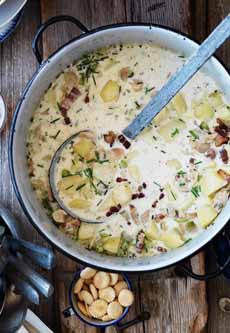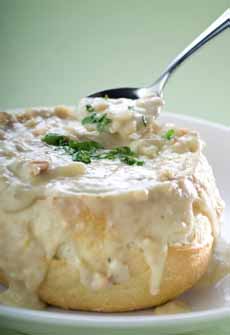New England Clam Chowder Recipe, History & Types Of Chowder
|
January 21st is National New England Clam Chowder Day, with a cream base. There is no National Manhattan Clam Chowder Day, honoring the tomato-base version; but you can have your choice of recipes on February 25th, a generic National Clam Chowder Day. > Check out the different types of chowder below. Chowder is a type of soup (see below for the major categories) made with potatoes and onions. It can include clams or other seafood, chicken, corn and creative variations. A friend of ours has an old family recipe from Maine for a haddock chowder. Feel free to combine fish and shellfish. How about a surf-and-turf chowder with both chicken and fish or shellfish? The word chowder has its roots in the Latin calderia, which originally meant a hearth for warming things and later came to mean a cooking pot. The word evolved to cauldron, which in French became chaudiere, a word that easily became chowder in English. The first chowders in our culture were fish chowders, made in cauldrons in fishing villages along the coast of France and in the Cornwall region of Southwestern England. When the fishermen came to the New World, they found clams in huge supply along the northern Atlantic coast, and clam chowder was born. Celebrate today—or any day demanding a hearty soup—with this yummy clam chowder. This one-pot recipe, adapted from Bon Appetit, can be made a day in advance, up to Step 5. Bring the chowder to a simmer before adding the clams on the second day. Substitutes: 1. BRING the clams and water to a boil in a large pot over high heat. Cook until the clams are just open, 8-10 minutes; discard any that do not open. Drain, reserving the broth. Transfer the clams to a baking pan, rimmed sheet or platter; let cool until comfortable to handle, remove the meat, and discard the shells. This step can be done 1 day ahead. Cover the clams and broth separately and refrigerate. |
|
|
|
2. CHOP the clams into bite-size pieces. Strain the broth through a fine-mesh sieve set over a large bowl. Add water to measure 6 cups. 3. MELT the butter in a large heavy pot over medium heat. Add the bacon and cook, stirring occasionally, until the fat is rendered and the bacon begins to brown, about 8 minutes. Add the celery, onion, and garlic. Cook, stirring often, until the onion is translucent, about 10 minutes. 4. ADD the reserved broth, potatoes, thyme, and bay leaf. Bring to a simmer and cook until the potatoes are tender, 20-25 minutes. 5. COMBINE the cornstarch with 2 tablespoons of water in a small bowl to form a slurry, and stir it into the chowder. Return the chowder to a boil to thicken. DO day ahead. Let cool; discard the bay leaf. 6. STIR in the clams and cream. Taste and season with salt as needed (some clams are brinier than others) and pepper; or allow diners to season their own. Divide the chowder among bowls. Garnish with chives or parsley. Serve with oyster crackers. *Discard any uncooked clams with broken or opened shells; these can collect bacteria. Conversely, discard any cooked clams with shells that have not opened. †Substitute Baby Dutch potatoes or other waxy potato (here are the different types of potatoes). |
||
 [4] A beautiful Manhattan Clam Chowder from an Australian cooking competition (photo © MasterChef).
[6] Sweet-flesh razor clams can look exotic, yet beautiful, in a clam chowder (photo © The Fish Society). |
THE DIFFERENT TYPES OF CLAM CHOWDER |
|
|
> THE HISTORY OF SOUP |
||




